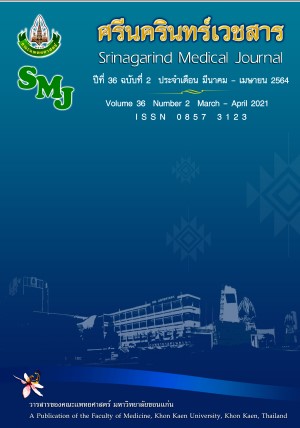Association meteorological data to cardiovascular disease
Keywords:
Cardiovascular disease; Meteorological data; Temperature; Atmosphere pressure; HumidityAbstract
Background and Objectives: Cardiovascular disease (CVDs) is the leading cause of death worldwide. The risks of developing chronic diseases are attributed to both genetic and environmental factors. The aim of this research was to assess and report on correlation between cardiovascular disease and environment.
Methods: This retrospective study evaluated meteorological data from the Modern-Era Retrospective Analysis for Research and Applications, version 2 (MERRA-2) along with monthly new CVDs cases in Thailand from Health Data Center (HDC) v 4.0 approved by the Ministry of Public Health (MOPH) during January 1, 2013 to December 31,2017.
Results: Monthly mean values of new CVDs cases in Thailand from January 1, 2013 through December 31, 2017 display increasing trends over time with mean 1990 cases/month. By the time series model, only 3 factors related with new CVDs cases significantly including temperature, surface pressure, and humidity.
Conclusion: Meteorological data like temperature, atmosphere pressure and humidity has effect to CVDs event.
References
2. Mazalin Protulipac J, Sonicki Z, Reiner Z. Cardiovascular disease (CVD) risk factors in older adults - Perception and reality. Arch Gerontol Geriatr. 2015;61(1):88-92.
3. Tzoulaki I, Elliott P, Kontis V, Ezzati M. Worldwide Exposures to Cardiovascular Risk Factors and Associated Health Effects: Current Knowledge and Data Gaps. Circulation. 2016;133(23):2314-2333.
4. Kinoshita M, Yokote K, Arai H, et al. Japan Atherosclerosis Society (JAS) Guidelines for Prevention of Atherosclerotic Cardiovascular Diseases 2017. J Atheroscler Thromb. 2018;25(9):846-984.
5. Rappaport SM, Smith MT. Epidemiology. Environment and disease risks. Science. 2010;330(6003):460-461.
6. Toro K, Bartholy J, Pongracz R, Kis Z, Keller E, Dunay G. Evaluation of meteorological factors on sudden cardiovascular death. J Forensic Leg Med. 2010;17(5):236-242.
7. Silverman RA, Ito K, Freese J, et al. Association of ambient fine particles with out-of-hospital cardiac arrests in New York City. Am J Epidemiol. 2010;172(8):917-923.
8. Sartini C, Barry SJ, Whincup PH, et al. Relationship between outdoor temperature and cardiovascular disease risk factors in older people. Eur J Prev Cardiol. 2017;24(4):349-356.
9. Modesti PA, Rapi S, Rogolino A, Tosi B, Galanti G. Seasonal blood pressure variation: implications for cardiovascular risk stratification. Hypertens Res. 2018;41(7):475-482.
10. Zeng J, Zhang X, Yang J, et al. Humidity May Modify the Relationship between Temperature and Cardiovascular Mortality in Zhejiang Province, China. Int J Environ Res Public Health. 2017;14(11).
11. Wang H, Kakehashi M, Matsumura M, Eboshida A. [Association between occurrence of acute myocardial infarction and meteorological factors]. J Cardiol. 2007;49(1):31-40.
12. Isik T, Ayhan E, Uyarel H, et al. Circadian, weekly, and seasonal variation in early stent thrombosis patients who previously underwent primary percutaneous intervention with ST elevation myocardial infarction. Clin Appl Thromb Hemost. 2013;19(6):679-684.
13. Danet S, Richard F, Montaye M, et al. Unhealthy effects of atmospheric temperature and pressure on the occurrence of myocardial infarction and coronary deaths. A 10-year survey: the Lille-World Health Organization MONICA project (Monitoring trends and determinants in cardiovascular disease). Circulation. 1999;100(1):E1-7.
14. Houck PD, Lethen JE, Riggs MW, Gantt DS, Dehmer GJ. Relation of atmospheric pressure changes and the occurrences of acute myocardial infarction and stroke. Am J Cardiol. 2005;96(1):45-51.
Downloads
Published
How to Cite
Issue
Section
License
Copyright (c) 2021 Srinagarind Medical Journal

This work is licensed under a Creative Commons Attribution-NonCommercial-NoDerivatives 4.0 International License.




